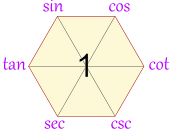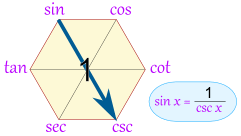Magic Hexagon for Trig Identities
 |
- Reciprocal Identities
You can also get the "Reciprocal Identities", by going "through the 1
 | Here you can see that sin(x) = 1 / csc(x) |
|
- Product Identities
The hexagon also shows that a function between any two functions is equal to them multiplied together (if they are opposite each other, then the "1" is between them):
 | |
| Example: tan(x)cos(x) = sin(x) | Example: tan(x)cot(x) = 1 |
sin(x)csc(x) = 1
tan(x)csc(x) = sec(x)
sin(x)sec(x) = tan(x)
cos(x)tan(x) = sin(x)
csc(x)cos(x) = cot(x)
cot(x)sec(x) = csc(x)
tan(x)csc(x) = sec(x)
sin(x)sec(x) = tan(x)
cos(x)tan(x) = sin(x)
csc(x)cos(x) = cot(x)
cot(x)sec(x) = csc(x)
- Quotient Identities
tan(x) = sin(x) / cos(x)
|  |
Well, we can now follow "around the clock" (either direction) to get all the "Quotient Identities":
| Clockwise |
|
| Counterclockwise |
|
- Pythagorean Identities
The Unit Circle shows us that
sin2 x + cos2 x = 1
The magic hexagon can help us remember that, too, by going clockwise around any of these three triangles:

And we have:
- sin2(x) + cos2(x) = 1
- 1 + cot2(x) = csc2(x)
- tan2(x) + 1 = sec2(x)

No comments:
Post a Comment